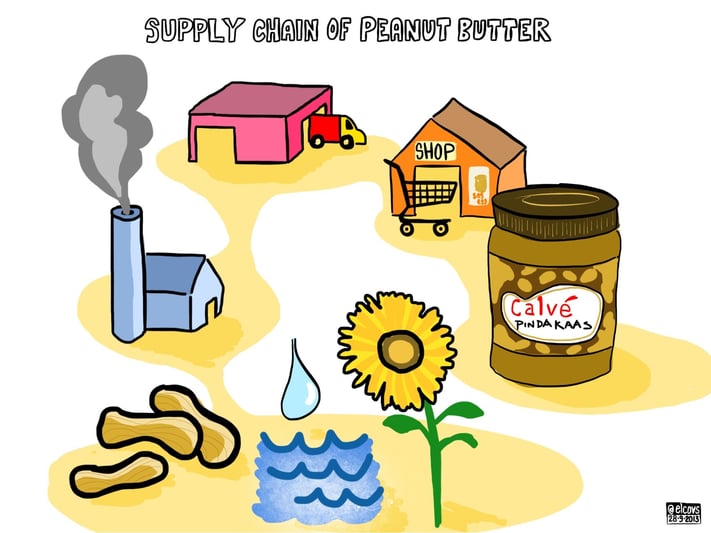Understanding Your Supply Chain

Supply Chain Management (SCM) is becoming more and more important in the manufacturing industry. Businesses around the world are taking a more active approach to supply chain management, resulting in smoother process integration, higher profits and more transparency.
Your supply chain is much more than just where your business sources raw materials, parts or other inputs. It's a long list of interactions, starting before raw material is even removed from the ground, and ending only when the end customer has a product in hand.
If your business is ignoring the supply chain, you could be left in the dark when it comes to supply chain disruptions, leading to unexpected losses.
Supply Chain Management is such a big deal that it even has its own association, the Council of Supply Chain Management Professionals (CSCMP), which defines supply chain management as "...the planning and management of all activities involved in sourcing and procurement, conversion, and all logistics management activities. Importantly, it also includes coordination and collaboration with channel partners, which can be suppliers, intermediaries, third-party service providers, and customers."
Essentially, SCM means thinking of the entire process of sourcing, producing and selling products as one big partnership. While dozens of individual businesses may be involved from beginning to end, they all stand to benefit from a robust supply chain.
So What's a Supply Chain?
The supply chain starts even before the raw material is removed from the ground, and ends when a customer purchases a finished product. A simple supply chain for a consumer product might look something like this:
- Legislation governing raw material extraction
- Organization A: extracts raw materials
- Organization B: shapes raw materials into basic parts
- Organization C: assembles basic parts, along with other basic parts, into a finished product
- Organization D: distributes finished products
- Customer: purchases product from Organization D
Upstream and Downstream
Upstream processes are those closer to the origin of the supply chain, like raw material extraction. The farther downstream a process gets, the closer it is to the end user.
If you're Organization B in this example, you'll most often deal directly with the two organizations on either side of you in the supply chain. You'll negotiate price for raw materials with Organization A, and if all goes well, you'll sell your basic parts to Organization C at a profit. As long as that pattern holds steady for everyone in the chain, business is good.
That's the key to a healthy supply chain: everyone in the supply chain has to generate a profit from the activity they perform. SCM is based on the idea that you don't just stand to benefit directly by selling parts to the next organization downstream, you also benefit when organizations upstream and farther downstream turn a profit. By paying a fair price for the raw materials you purchase from Organization A, you're helping to ensure the sustainability of your supply chain.
Minimizing Supply Chain Risk
Even when things are going well, you could experience a supply chain disruption. An upstream supply chain disruption could be an issue with raw material extraction. Perhaps new legislation was passed, or perhaps a mine was closed after an earthquake. A downstream supply chain disruption could be a shipping mishap, a new import tax or a sudden reduction in customer demand.
A big part of supply chain management is understanding, quantifying and minimizing the risk of disruption. Companies can most easily minimize internal risk, which is risk caused by activities within their own businesses. A solid supply chain management strategy can help reduce external risk as well.
Internal supply chain risks
- Business personnel changes
- Ineffective management
- Regulatory non-compliance
- Inadequate quoting or planning
External supply chain risks
- Interruptions in raw-material supply
- Political, social or weather events
- Supply-chain partners' financial stability, facility conditions and regulatory compliance
By working with other organizations throughout the supply chain, businesses can collaborate to identify and eradicate supply chain risks.
Learn more about choosing the right suppliers to join your supply chain:
"Peanut Butter Supply Chain" image by Elco van Staveren. Made available for restricted use under Attribution-ShareAlike 2.0 Generic (CC BY-SA 2.0)
Tags: Manufacturing, Supply chain, supply chain management

Written by Jeff Cook
Jeff Cook is Chief Sales and Marketing Officer for Eagle Alloy in Muskegon, MI. While enlisted in the Marine Corps Reserves, he began working at Eagle Alloy in 1986 as a snag grinder on 3rd shift after his father told him to “Get a job!” Jeff is past President of the American Foundry Society. His passions include educating young people on the careers and advancement available in the metalcasting industry.




